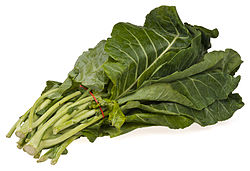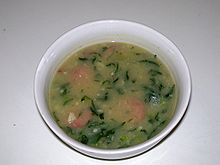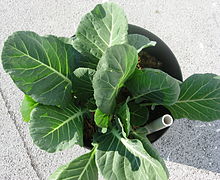- Collard greens
-
- "Berza" redirects here. For the village in Romania see Santa Mare
Collard greens 
A bundle of collard greensDetails Species Brassica oleracea Cultivar group Acephala Group Origin unknown Cultivar group members Many, and some are known by other names. Collard greens are various loose-leafed cultivars of Brassica oleracea (Acephala Group), the same species as cabbage and broccoli. The plant is grown for its large, dark-colored, edible leaves and as a garden ornamental, mainly in Brazil, Portugal, the southern United States, many parts of Africa, Montenegro, Bosnia and Herzegovina, southern Croatia, Spain and in Pakistan, as well as in Kashmir region of both India and Pakistan. They are classified in the same cultivar group as kale and spring greens, to which they are genetically similar. The name "collard" is a shortened form of the word "colewort" (cabbage plant).
The plant is also called couve in Brazil, couve-galega in Portugal, kovi or kobi in Cape Verde, berza in Spanish-speaking countries, raštika in Bosnia and Herzegovina and Croatia and raštan in Montenegro and Serbia. In Kashmir, it is called haak. In Congo, Tanzania and Kenya (East Africa), the plant is called sukuma wiki.
Contents
Description
The cultivar group name Acephala ("without a head" in Greek) refers to the fact that this variety of B. oleracea does not have the usual close-knit core of leaves (a "head") like cabbage. The plant is a biennial where winter frost occurs, and perennial in even colder regions. It is also moderately sensitive to salinity. It has an upright stalk, often growing up to two feet tall. The plant is very similar to kale. Popular cultivars of collard greens include 'Georgia Southern', 'Morris Heading', 'Butter Collard' (or couve-manteiga), and couve tronchuda.
Cultivation and storage
The plant is commercially cultivated for its thick, slightly bitter, edible leaves. They are available year-round, but are tastier and more nutritious in the cold months, after the first frost. For best texture, the leaves should be picked before they reach their maximum size, at which stage the leaves will be thicker and should be cooked differently from the new leaves. Age will not affect flavor. Flavor and texture also depend on the cultivar; the couve-manteiga and couve tronchuda are especially appreciated in Brazil and Portugal.
Fresh collard leaves can be stored for up to 10 days if refrigerated to just above freezing (1°C) at high humidity (>95%). In domestic refrigerators, fresh collard leaves can be stored for about three days. Once cooked, they can be frozen and stored for greater lengths of time.
Nutritional information
Collard Nutritional value per 100 g (3.5 oz) Energy 151 kJ (36 kcal) Carbohydrates 7.1 g Fat 0.4 g Protein 3 g Vitamin A equiv. 575 μg (72%) Vitamin C 26 mg (31%) Vitamin K 623 μg (593%) Calcium 210 mg (21%) Percentages are relative to US recommendations for adults.
Source: USDA Nutrient DatabaseWidely considered to be a healthy food, collards are good sources of vitamin C and soluble fiber, and contain multiple nutrients with potent anticancer properties, such as diindolylmethane and sulforaphane.[citation needed] Roughly a quarter pound (approx. 100 g) of cooked collards contains 46 Calories.
Researchers at the University of California at Berkeley have recently discovered that 3,3'-diindolylmethane in Brassica vegetables such as collard greens is a potent modulator of the innate immune response system with potent antiviral, antibacterial and anticancer activity.[1]
Culinary use
North America
Collard greens are a staple vegetable of southern U.S. cuisine. They are often prepared with other similar green leaf vegetables, such as kale, turnip greens, spinach, and mustard greens in "mixed greens". They are generally eaten year-round in the South. Typical seasonings when cooking collards can consist of smoked and salted meats (ham hocks, smoked turkey drumsticks, pork neckbones, fatback or other fatty meat), diced onions, vinegar, salt, and black, white, or crushed red pepper. Traditionally, collards are eaten on New Year's Day, along with black-eyed peas or field peas and cornbread, to ensure wealth in the coming year, as the leaves resemble folding money.[citation needed] Cornbread is used to soak up the "pot liquor", a nutrient-rich collard broth. Collard greens may also be thinly sliced and fermented to make collard kraut, which is often cooked with flat dumplings.
Brazil and Portugal
 Caldo verde is a popular Portuguese soup made of collard greens.
Caldo verde is a popular Portuguese soup made of collard greens.
In Portuguese and Brazilian cuisine, collard greens (or couve) are common accompaniments of fish and meat dishes. They are a standard side dish for feijoada, a popular pork and beans-style stew. The leaves are sliced into strips, 1/2 cm wide (sometimes by the grocer or market vendor, with a special hand-cranked slicer) and sautéed with oil or butter, flavored with garlic, onion, and salt. Sometimes, it is also eaten fresh.
Thinly sliced collard greens are also the main ingredient of a popular soup, caldo verde (green broth).
The juice pressed from fresh leaves and leaf stalks, taken regularly, is popularly believed to be a remedy for gout, bronchitis, and blood circulation problems.[citation needed]
Kashmir Region (India and Pakistan)
In Kashmir, this vegetable is a very renowned one. It finds its place in almost every meal in Kashmiri houses. Both leaves and roots are consumed. Leaves in the bud are harvested by pinching in early spring, when the dormant buds sprout and give out tender leaves. Also, seedlings of 35–40 days' age, as well as mature plants, are pulled out along with roots from thickly sown beds. When the extending stem bears alternate leaves in quick succession during on-season, older leaves are harvested periodically. Before the autumn season, the apical portion of stem is removed along with the whorled leaves.
The roots and the leaves may be cooked together or separately. A common dish is haak rus, a soup of whole collard leaves cooked in water, salt and oil, usually consumed with rice. The leaves are also cooked along with meat, fish or cheese In winter, collard leaves and roots are fermented to form a very popular pickle called haak-e-aanchaar.
Egypt
In Egypt, collard greens, called sel' (with the apostrophe denoting a glottal stop), are used solely in a garlicky soup with colocasia, or taro root.
South Carolina
In 2011, the South Carolina General Assembly voted on a bill sponsored by Sen. Jake Knotts (R), Lexington County, to make collard greens the State leafy green.
References
- ^ Gong Y, Sohn H, Xue L, Firestone GL, Bjeldanes LF (May 2006). "3,3'-Diindolylmethane is a novel mitochondrial H(+)-ATP synthase inhibitor that can induce p21(Cip1/Waf1) expression by induction of oxidative stress in human breast cancer cells". Cancer Res. 66 (9): 4880–7. doi:10.1158/0008-5472.CAN-05-4162. PMID 16651444. http://cancerres.aacrjournals.org/cgi/pmidlookup?view=long&pmid=16651444.
External links
- Kale and Collard info from Texas A&M University
- Another one
- East Palo Alto, CA. Collard Greens Festival
Brassica Brassica carinata • Brassica juncea • Brassica napus • Brassica nigra • Brassica rapa • Brassica tournefortii • Canola • Celery cabbage • Chinese cabbage • Coleslaw • Collard greens • Kapusta • Kohlrabi • Meigan cai • Mustard plant • Napa cabbage • Pao cai • Rapeseed • Rapini • Rutabaga • Sauerkraut • Spring greens • Suan cai • Tatsoi • Tianjin preserved vegetable • Triangle of U • Turnip • Zha cai
Wikimedia Foundation. 2010.

